This article describes in details counter unemployment policies as well as evaluates methods that governments can use to combat unemployment.
Introduction to counter unemployment policies
There are several things the government can do to help resolve the problems caused by unemployment including:
- Demand management. Demand management to help assist against cyclical unemployment
- Supply side policies. Supply side policies designed to aid other types of unemployment such as structural unemployment
Let’s take a look at these two approaches to fixing the problem of unemployment.
1. Demand management
Where cyclical unemployment exists, fiscal policy or monetary policy can be used to shift the Aggregate Demand (AD) curve outwards.
For instance, the government can spend more money on infrastructure to increase the Aggregate Demand (AD) curve and hopefully cause the multiplier effect.
Or, the government can decrease interest rates to help encourage spending and investment from consumers and businesses.
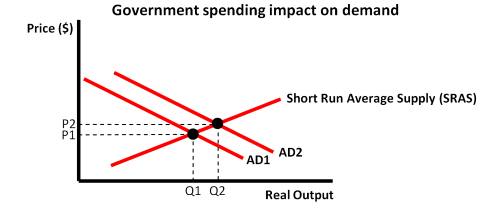
Classical View vs. Keynesian View
Different economists have differing views on the long term effectiveness of this technique. Before we can understand this, let’s take a look again at Production Possibility Frontier (PPF).
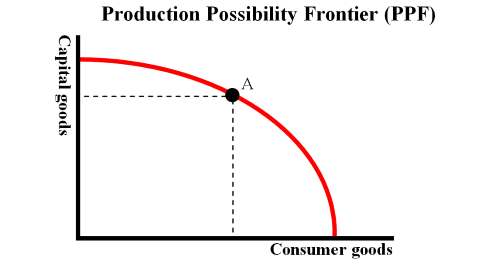
This diagram shows the potential output of the economy. That is, the quantity that could be produced, if the economy is efficiently using all resources. If the quality or quantity of resources is increased, then the potential output of the economy is increased and the economy will grow.
Production Possibility Frontier (PPF) is represented on a Aggregate Demand (AD) / Aggregate Supply (AS) diagram as the Long Run Aggregate Supply (LRAS) curve.
A. Classical View
Classical economists argue that the only effect of demand management is inflation. The government’s efforts to reduce unemployment are only successful for a short period of time, though the price level has increased in the long term.
Here, growth in potential output is represented as an upward shift within the vertical section of the Long Run Aggregate Supply (LRAS) curve.
An increase in government spending will cause the Aggregate Demand (AD1) curve to shift outwards to the right resulting in the Aggregate Demand (AD2) curve. In the short run, the economy is able to increase production from Q1 to Q2. Firms will require a greater quantity of resources including labor. As this output level is beyond the economy’s ability to produce labor will be paid overtime and some individuals who are unemployed may find work. The resulting demand for labor and overtime pay will lead to an increase in wages, which will cause the Short Run Aggregate Supply (SRAS1) curve to shift upwards resulting in the Short Run Aggregate Supply (SRAS2) curve. The economy will return to the original output level of Q1, the government’s efforts to reduce unemployment was only successful for a short period of time, though the price level has increased.
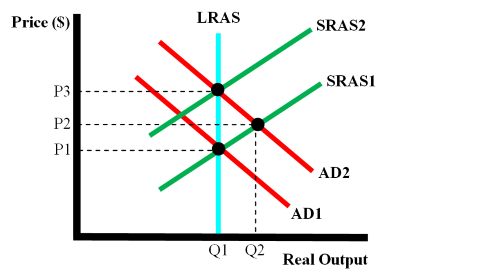
The second diagram shows what occurs if there is an increase in the quality or quantity of resources. This can be achieved with supply side policies. So for example, if the government spend on training and education it may result in inflation as seen in the first diagram above. However in time as the economy starts to experience the benefit of spending on education etc, the Long Run Aggregate Supply (LRAS) curve may shift from LRAS1 to LRAS2 resulting in a larger economy and a lower price level.
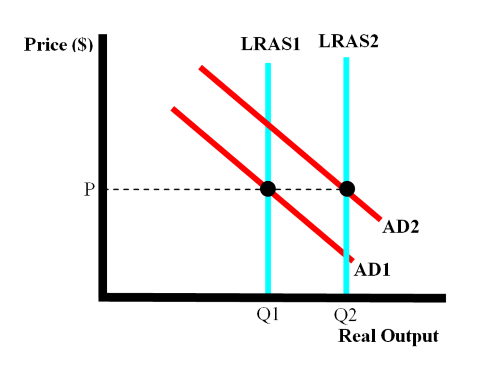
This supports the classical viewpoint that supply side policy is effective in reducing unemployment.
B. Keynesian View
Keynesian economists believe that demand management policies are helpful until full employment is achieved.
The diagrams show how the effectiveness of demand management is dependent upon the current level of unemployment.
The horizontal section of the Keynesian Long Run Aggregate Supply (LRAS) curve represents high unemployment. Classical economists support the idea that markets will clear and quickly return to equilibrium, however the great depression of the 1930’s suggested otherwise.
The Keynesian Long Run Aggregate Supply (LRAS) curve is the result of markets failing to correct themselves quickly. Supporters of Keynesian economics believe that during a period of high unemployment, governments can help the economy through expansionary fiscal and monetary policy (e.g. increased government spending or lower interest rates) without fear of increasing inflation. In the first diagram, an outward shift of aggregate demand from Aggregate Demand (AD1) to Aggregate Demand (AD2) will help to reduce unemployment, however since many individuals are still out of work existing labor are unable to bargain for higher salaries.
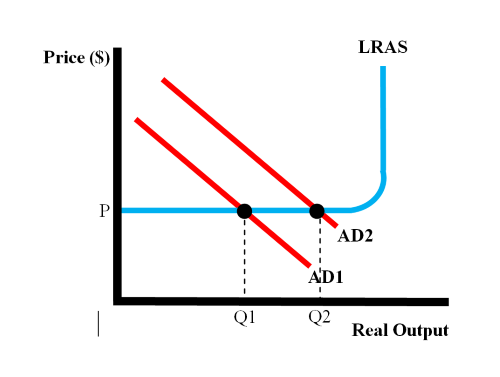
However in the second diagram, expansionary policy will cause aggregate demand to shift through the curved section of the Long Run Aggregate Supply (LRAS) curve. The part of the curve represents the economy being ’close to full employment’. During this section, the shift of Aggregate Demand (AD1) to Aggregate Demand (AD2) will reduce unemployment levels and make it more difficult for firms to find suitable labor. As skills are becoming more scarce the labor force is able to bargain for higher salaries resulting in inflation as seen from P1 to P2.
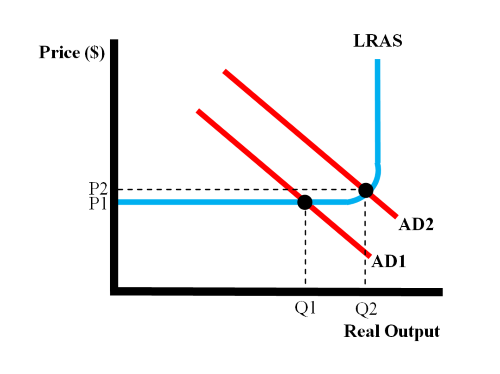
In the final diagram the economy is operating at full employment, this part of the curve is the same as the classical viewpoint, an attempt to reduce unemployment will result in inflation as an outward shift in aggregate demand from Aggregate Demand (AD1) to Aggregate Demand (AD2) will retain an output level of Q1. But, it will result in higher prices from P1 to P2.

2. Supply side policies
Although divided by demand management policies, economists agree regarding the use of supply side policies to resolve some types of unemployment.
Below are just some examples of what can be done to aid other types of unemployment, you are encouraged to do further reading to increase your understanding of the subject.
1. Frictional unemployment
Improving the level, quality and accessibility to job information to the unemployed, such as setting up more job centers to help people find work. An alternative method is to reduce or remove unemployment benefits for short-term unemployed. This will encourage people to get back into work more quickly.
2. Structural unemployment
Governments can provide incentives to firms to encourage them to move to areas with high levels of unemployment. When the collapse of traditional industries in the UK caused high unemployment in the North East of England the government created commercial zones which gave firms TAX deductions and/or rent free benefits for setting up and employing local people. A commercial zone is an area specifically set aside for use by industry. This campaign was successful at attracting many firms including Japanese firms Nissan and NSK, which could have set up on domestic ground or even in neighboring countries such as China, Vietnam of Thailand where labor is cheaper than the UK. Money can also be spent to retrain workers who have lost or will lose their work. This prepares workers for other industries and keeps their skills up to date. The French government was particularly successful at this when the French mining industry was under threat during the 80’s.
3. Classical unemployment
Financial incentives can be offered to firms to employ more people, specifically the long term unemployed. Like frictional unemployment, reducing or removing unemployment benefits will encourage people to get back into work. Some economists particularly classical theory supporters suggest reducing trade union power and removing minimum wages will cause a reduction in the real wage rate, causing an increase in demand for labor.
Summary about counter unemployment policies
Unemployment causes various costs to individuals, communities and even the whole economy, including not only financial costs but also psychological costs.
Though unemployment is regarded as a negative factor, it can reduce inflation and encourage labor to be more flexible.
There are various methods governments to combat unemployment some designed to reduce specific types of unemployment.
 Articles: 1,432 · Readers: 748,000 · Views: 2,231,258
Articles: 1,432 · Readers: 748,000 · Views: 2,231,258 